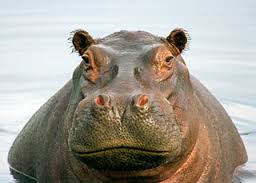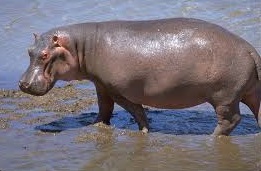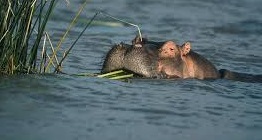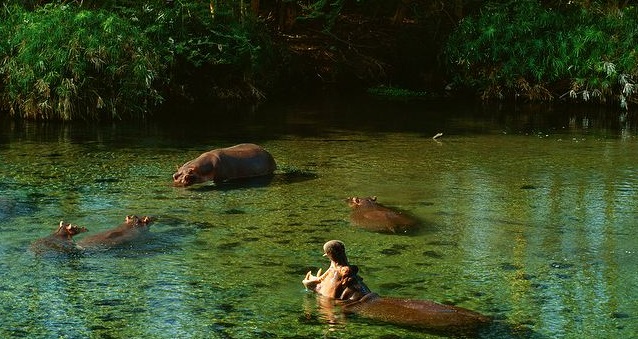
Hippopotamus
(Hippopotamus amphibius)

The common hippopotamus, or hippo, is a large, mostly herbivorous mammal in sub-Saharan Africa, and one of only two extant species in the family Hippopotamidae, the other being the pygmy hippopotamus (Choeropsis liberiensis or Hexaprotodon liberiensis). The name comes from the ancient Greek for "river horse" (ἱπποπόταμος). After the elephant and rhinoceros, the common hippopotamus is the third-largest type of land mammal and the heaviest extant artiodactyl. Despite their physical resemblance to pigs and other terrestrial even-toed ungulates, the closest living relatives of the Hippopotamidae are cetaceans (whales, porpoises, etc.) from which they diverged about 55 million years ago. The common ancestor of whales and hippos split from other even-toed ungulates around 60 million years ago. The earliest known hippopotamus fossils, belonging to the genus Kenyapotamus in Africa, date to around 16 million years ago.
Common hippos are recognisable by their barrel-shaped torsos, wide-opening mouths revealing large canine tusks, nearly hairless bodies, columnar-like legs and large size; adults average 1,500 kg (3,300 lb) and 1,300 kg (2,900 lb) for males and females respectively, making them the largest species of land mammal after the three species of elephants and the white and Indian rhinoceros. Despite its stocky shape and short legs, it is capable of running 30 km/h (19 mph) over short distances. The hippopotamus is a highly aggressive and unpredictable animal and is ranked among the most dangerous animals in Africa. Nevertheless, they are still threatened by habitat loss and poaching for their meat and ivory canine teeth.
The common hippopotamus is semiaquatic, inhabiting rivers, lakes and mangrove swamps, where territorial bulls preside over a stretch of river and groups of five to thirty females and young. During the day, they remain cool by staying in the water or mud; reproduction and childbirth both occur in water. They emerge at dusk to graze on grasses. While hippopotamuses rest near each other in the water, grazing is a solitary activity and hippos are not territorial on land.
Conservation status
Vulnerable
Scientific classification |
|
| Kingdom: | Animalia |
| Phylum: | Chordata |
| Class: | Mammalia |
| Order: | Artiodactyla |
| Family: | Hippopotamidae |
| Genus: | Hippopotamus |
| Specie: | Hippotamus amphibius |
Description

Hippopotamuses are among the largest living land mammals, being only smaller than elephants and some rhinoceroses. Mean adult weight is around 1,500 kg (3,300 lb) and 1,300 kg (2,900 lb) for males and females respectively, very large males can reach 2,000 kg (4,400 lb) and an exceptional male weighing almost 2,700 kg (6,000 lb) has been reported. Male hippos appear to continue growing throughout their lives while females reach maximum weight at around age 25. Different from all other large land mammals, hippos are of semiaquatic habits, spending the day in lakes and rivers. The eyes, ears, and nostrils of hippos are placed high on the roof of their skulls. This allows these organs to remain above the surface while the rest of the body submerges. Their barrel-shaped bodies have graviportal skeletal structures, adapted to carrying their enormous weight, and their specific gravity allows them to sink and move along the bottom of a river. Hippopotamuses have small legs (relative to other megafauna) because the water in which they live reduces the weight burden. Though they are bulky animals, hippopotamuses can gallop at 30 km/h (19 mph) on land but normally trot. They are incapable of jumping but do climb up steep banks. Despite being semiaquatic and having webbed feet, an adult hippo is not a particularly good swimmer nor can it float. It is rarely found in deep water; when it is, the animal moves by porpoise-like leaps from the bottom. The testes of the males descend only partially and a scrotum is not present. In addition, the penis retracts into the body when not erect. The genitals of the female are unusual in that the vagina is ridged and two large diverticula protrude from the vulval vestibule. The function of these is unknown.
The hippo's jaw is powered by a large masseter and a well-developed digastric; the latter loops up behind the former to the hyoid. The jaw hinge is located far back enough to allow the animal to open its mouth at almost 180°. A moderate folding of the orbicularis oris muscle allows the hippo to achieve such a gape without tearing any tissue. On the National Geographic Channel television program, "Dangerous Encounters with Brady Barr", Dr. Brady Barr measured the bite force of an adult female hippo at 8,100 newtons (1,800 lbf); Barr also attempted to measure the bite pressure of an adult male hippo, but had to abandon the attempt due to the male's aggressiveness. Hippopotamus teeth sharpen themselves as they grind together. The lower canines and lower incisors are enlarged, especially in males, and grow continuously. The incisors can reach 40 cm (1.3 ft), while the canines reach up to 50 cm (1.6 ft). The canines and incisors are used for combat and play no role in feeding. Hippos rely on their broad horny lips to grasp and pull grasses which are then ground by the molars. The hippo is considered to be a pseudoruminant; it has a complex three-chambered stomach but does not "chew cud". Unlike most other semiaquatic animals, the hippopotamus has very little hair. The skin is 6 cm (2 in) thick, providing it great protection against conspecifics and predators. By contrast, its subcutaneous fat layer is thin. The animals' upper parts are purplish-gray to blue-black, while the under parts and areas around the eyes and ears can be brownish-pink. Their skin secretes a natural sunscreen substance which is red-coloured. The secretion is sometimes referred to as "blood sweat", but is neither blood nor sweat. This secretion is initially colourless and turns red-orange within minutes, eventually becoming brown. Two distinct pigments have been identified in the secretions, one red (hipposudoric acid) and one orange (norhipposudoric acid). The two pigments are highly acidic compounds. Both pigments inhibit the growth of disease-causing bacteria; as well, the light absorption of both pigments peaks in the ultraviolet range, creating a sunscreen effect. All hippos, even those with different diets, secrete the pigments, so it does not appear that food is the source of the pigments. Instead, the animals may synthesize the pigments from precursors such as the amino acid tyrosine. Nevertheless, this natural sunscreen cannot prevent the animal's skin from cracking if it stays out of water too long.
A hippo's lifespan is typically 40-50 years. Donna the Hippo was the oldest living hippo in captivity. She lived at the Mesker Park Zoo in Evansville, Indiana in the US until her death in 2012 at the age of 61. The oldest hippo ever recorded was called Tanga; she lived in Munich, Germany, and died in 1995 at the age of 61.
Distribution
Hippopotamus amphibius was widespread in North Africa and Europe during the Eemian and late Pleistocene until about 30,000 years ago. Archaeological evidence exists of its presence in the Levant, dating to less than 3,000 years ago. The species was common in Egypt's Nile region during antiquity, but has since been extirpated. Pliny the Elder writes that, in his time, the best location in Egypt for capturing this animal was in the Saite nome; the animal could still be found along the Damietta branch after the Arab Conquest in 639. Hippos are still found in the rivers and lakes of the northern Democratic Republic of the Congo, Uganda, Tanzania and Kenya, north through to Ethiopia, Somalia and Sudan, west to The Gambia, and south to South Africa.Diet

Hippos prefer to graze on grass close to water beds. Because of the shape of their teeth, they seek out short, cropped patches of vegetation that is easily chewed. They may walk up to 6 miles or five hours in a loop overnight to find and devour the right stuff. They may consume fruit if happens to fall on the ground. With their sharp hearing, they can hear the sound of dropping fruit.
In captivity, a hippo eats a combination of plants -- including hay, alfalfa and lettuce. On special occasions, hippos may get pumpkins or melons as a treat. Zoos provide hippos and other herbivores with special vegetarian pellets that fulfill their nutritional needs.
Hippos don't move a lot during the day, so they consume just 88 pounds of food per night. This may sound like a lot, but when you compare it with their size, it comes out to just 1 percent or 1.5 percent of the individual hippo's body weight. In comparison, the largest cattle eat 2.5 percent of their body weight daily.
On rare occasions, hippos in the wild will eat meat or insects. Usually this is due to scarcity of the grasses, vegetation and fruit that makes up their regular diet, such as during a drought. Hippos may chew on water plants, but these flora do not make up a significant portion of their diet.
Behaviour

Hippos can be found in both savannah and forest areas. Proper habitat requires enough water to submerge in and grass nearby. Larger densities of the animals inhabit quiet waters with mostly firm, smooth sloping beaches. Males may be found in very small numbers in rapid waters in rocky gorges. With the exception of eating, most of hippopotamuses' lives -from fighting with other hippos, mating, to parturition- occurs in the water. Hippos leave the water at dusk and travel inland, sometimes up to 10 km (6 mi), to graze on short grasses, their main source of food. They spend four to five hours grazing and can consume 68 kg (150 lb) of grass each night. Like almost any herbivore, they consume other plants if presented with them, but their diet in nature consists almost entirely of grass, with only minimal consumption of aquatic plants. Hippos are born with sterile intestines, and require bacteria obtained from their mothers' feces to digest vegetation. Hippos have (rarely) been filmed eating carrion, usually close to the water. There are other reports of meat-eating, and even cannibalism and predation. The stomach anatomy of a hippo is not suited to carnivory, and meat-eating is likely caused by aberrant behaviour or nutritional stress.
Hippo defecation creates allochthonous deposits of organic matter along the river beds. These deposits have an unclear ecological function. A 2015 study suggests that hippo dung provides nutrients from terrestrial material for fish and aquatic invertebrates. Because of their size and their habit of taking the same paths to feed, hippos can have a significant impact on the land across which they walk, both by keeping the land clear of vegetation and depressing the ground. Over prolonged periods, hippos can divert the paths of swamps and channels. Adult hippos move at speeds up to 8 km/h (5 mph) in water; typically resurfacing to breathe every three to five minutes. The young have to breathe every two to three minutes. The process of surfacing and breathing is automatic. A hippo sleeping underwater rises and breathes without waking. A hippo closes its nostrils when it submerges into the water. As with fish and turtles on a coral reef, hippos occasionally visit cleaning stations and signal, by opening their mouths wide, their readiness for being cleaned of parasites by certain species of fishes. This is an example of mutualism in which the hippo benefits from the cleaning, while the fish receive food.
Reproduction

Female hippos reach sexual maturity at five to six years and have a gestation period of eight months. A study of endocrine systems revealed that female hippopotamuses may begin puberty as early as three or four years. Males reach maturity at around 7.5 yr. A study of hippopotamus reproductive behaviour in Uganda showed that peak conceptions occurred during the end of the wet season in the summer, and peak births occurred toward the beginning of the wet season in late winter. This is because of the female's oestrous cycle; as with most large mammals, male hippopotamus spermatozoa is active year-round. Studies of hippos in Zambia and South Africa also showed evidence of births occurring at the start of the wet season. After becoming pregnant, a female hippopotamus will typically not begin ovulation again for 17 months.
Mating occurs in the water, with the female submerged for most of the encounter, her head emerging periodically to draw breath. Baby hippos are born underwater at a weight between 25 and 50 kg (55 and 110 lb) and an average length of around 127 cm (4.17 ft), and must swim to the surface to take their first breaths. A mother typically gives birth to only one calf, although twins also occur. The young often rest on their mothers' backs when the water is too deep for them, and they swim under water to suckle. They suckle on land when the mother leaves the water. Weaning starts between six and eight months after birth, and most calves are fully weaned after a year. Like many other large mammals, hippos are described as K-strategists, in this case typically producing just one large, well-developed infant every couple of years (rather than many small, poorly developed young several times per year as is common among small mammals such as rodents).
Aggression
Hippopotamuses are aggressive animals. Hippos that attack other animals are often either territorial bulls or females protecting their calves. Hippopotamus coexist with a variety of formidable predators. Nile crocodiles, lions and spotted hyenas are known to prey on young hippos. However, due to their aggression and size, adult hippopotamus are not usually preyed upon by other animals. Cases where large lion prides or cooperating groups of Nile crocodiles have successfully preyed on adult hippopotamus have been reported; however, this predation is exceptionally rare. Crocodiles are frequent targets of hippo aggression, probably because they often inhabit the same riparian habitats; crocodiles may be either aggressively displaced or killed by hippopotamuses. Hippos are also very aggressive towards humans, whom they sometimes attack whether in boats or on land, commonly with no apparent provocation, and are widely considered to be one of the most dangerous large animals in Africa.Hippos mark their territory by defecation. While depositing the faeces, hippos spin their tails to distribute their excrement over a greater area. "Yawning" serves as a threat display. When fighting, male hippos use their incisors to block each other's attacks and their large canines to inflict injuries. When hippos become over-populated or a habitat is reduced, bulls sometimes attempt infanticide, but this behaviour is not common under normal conditions. Incidents of hippo cannibalism have been documented, but this is believed to be the behaviour of distressed or sick hippos.
Zoológico de Vallarta A. C.
Leave your comments, your opinion is important to us

